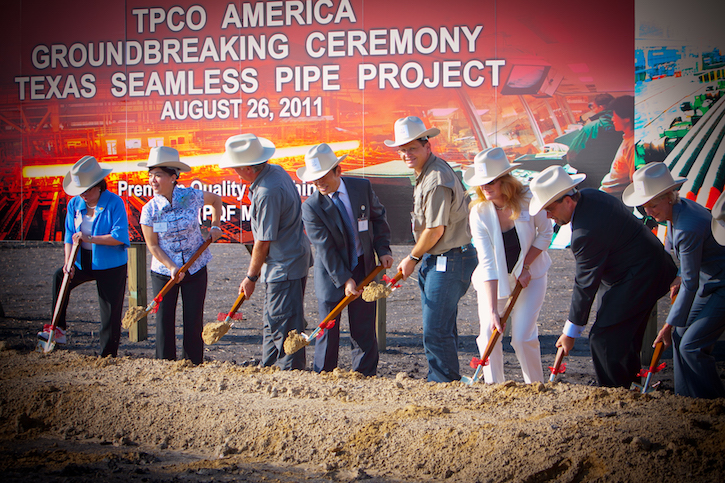
By Claron Niu
The people of Gregory, Texas, a town of 2,000 near Corpus Christi in Texas, were delighted when the Tianjin Pipe Company (TPCO) decided in January 2009 to invest $1.3 billion to build a pipe factory. It was unusual for a Chinese company to find its way to Gregory, and local development officials had fought hard to win the investment over other communities in Louisiana, Mississippi, and Baytown, Texas, a town in the Houston metropolitan area. The local government offered tax incentives and turned on the Southern charm—even serving pie to the potential Chinese investors—and eventually won the day.
The investment was a huge deal in Gregory. As described in a 2014 Paulson Institute Investment Case Study, the pipe factory was to make specialty seamless pipes that are used in shale oil fracking that can withstand far higher pressures than conventional pipes. At the time, TPCO’s pledge was the largest Chinese manufacturing investment ever made in the United States. What has happened since 2009 has had an even larger impact on the community. And it all began with TPCO.
Since 2009, a total of $28.6 billion has been invested in the South Bend, an area that includes Corpus Christi, San Patricio County, and Gregory—transforming the region. Land values in the South Bend have increased four-fold, and local economists estimate that from 2011–2015, approximately 9,600 new construction jobs were created by the 29 firms assisted by the Corpus Christi Regional Economic Development Corporation (CCREDC), a local development board.
Why did the money pour in? There is no question that the South Bend has benefited greatly from its proximity to the Eagle Ford Shale field and the Corpus Christi port, an energy exporter that handles the fifth-most cargo in the United States by tonnage. But some local officials suggest that the TPCO deal played a significant role in the influx of investment, signaling to other multinationals that the South Bend was a good place for companies to place their bets. The TPCO project “put the region on the map initially,” says Foster Edwards, executive director of the San Patricio Economic Development Corporation, which works to attract investment to the South Bend. According to Claudia Jackson, a director at Del Mar College, a nearby two-year college where TPCO has contributed to a training program, there has been an economic “rejuvenation” in the region since the TPCO investment came in.
Meanwhile, the TPCO project itself hasn’t panned out exactly as expected: the company so far has only completed Phase 1, a pipe assembly plant. Out of the pledged $1.3 billion, local officials estimate that about $400 million has been invested so far. Phase 2, the bigger seamless pipe manufacturing facility, originally scheduled for completion in mid-2016, has been postponed until the end of 2017 as a result of the drop in oil prices since 2014—which made shale and fracking less competitive. To date, the project has only created 50 jobs, far fewer than the 600 originally promised.
But TPCO has attempted to involve itself in the community, even though a cultural barrier exists. Its executives regularly participate in monthly lunches held by the CCREDC, where foreign investors in the South Bend gather to discuss upcoming projects and changes. According to Mike Culbertson, Chief Operating Officer of the CCREDC, when other Asian companies have come to the South Bend looking to invest, TPCO employees have helped with translation.
Those efforts may bode well for TPCO, especially since a Paulson Institute Investment Paper authored by Institute Chairman Hank Paulson argues that communications are crucial for Chinese investors to succeed in the United States. The paper points out that investors need to bear in mind the importance of transparency and clear communication with local communities, who expect investments to bring new jobs and opportunities. (TPCO did not respond directly to our media inquiries.)
In anticipation of future jobs, meanwhile, Del Mar College has trained 74 local workers in pipe welding, using a $117,223 grant from the Texas Workforce Commission, a state board that financially supports employment-training programs. TPCO donated $70,000 worth of pipes to Del Mar to support that program. Del Mar’s Jackson says the “partnership between Del Mar College and TPCO remains strong.”
South Bend officials are still looking for more investment from China to create more jobs. In July 2016, Iain Vasey, president of the Corpus Christi Regional Economic Development Corporation, visited China to try and attract more Chinese investment into the community. He met with TPCO during the trip and, according to Vasey, was assured that the firm still had significant interest in developing the factory.
Though the investment has been smaller than expected so far, local development officials still credit TPCO for kick-starting a wave of investment. Nowadays, at 7:30am and quitting time around 5:30pm, a long line of traffic snakes along the highway that leads to all the new factories—a problem that the region never faced before 2009. The traffic, Foster Edwards, Executive Director of San Patricio’s Economic Development Corporation, says with a laugh, is the “worst in South Texas.”
Claron Niu is an intern at the Paulson Institute and a third-year history student at the University of Chicago.


